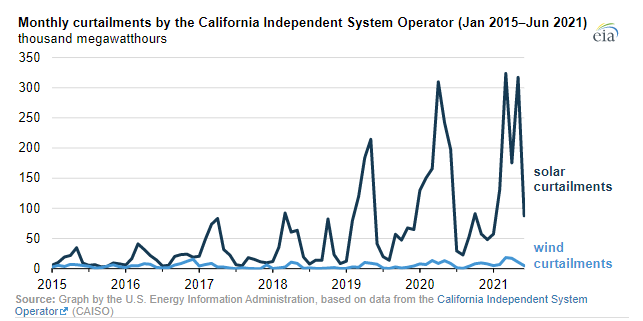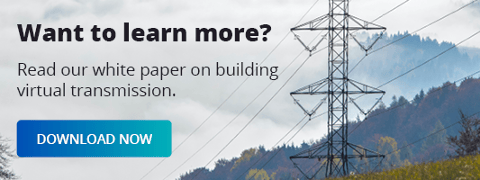This is the first deep dive in our series on the five Challenges transmission system operators (TSOs) will face today and in the future. If you’re new to the series, read our overview post which summarizes each challenge.
In a bid to limit the effects of climate change—and in response to the rapidly improving economics of renewable technology—government and regulators are setting decarbonization goals, and power producers are adding new renewable generation assets to their portfolios. Aiming to maximize the output of these resources, power providers locate renewable generation where sun, wind, and rivers are in greatest supply. Some of those locations are remote, far from demand centers and decommissioned fossil fuel plants. The net effect is an increasingly decentralized energy system, with power needing to travel even further from generation to utilization.
Decentralization of energy sources, combined with the inherent intermittency of renewables, fundamentally changes how we use our electricity thoroughfares. Lines built years ago to support modest, consistent local power supply and demand are being stretched to distribute much more power much farther. The results are congestion and curtailment, threatening to put the brakes on badly needed renewable asset developments.

To pave the way for more renewables to come online, power providers must widen their focus beyond where and how renewables are built; they must focus on grid architecture holistically. While new infrastructure is needed to maintain stability, building costly high-capacity lines that will sit underutilized most of the time won’t solve these challenges. With more nimble approaches, power providers can still hit sustainability targets while managing economic costs by maximizing system efficiency and utilization. Indeed, Transmission System Operators (TSOs) are already beginning to adopt such approaches.
TSO Solutions to Intermittency and Congestion in the Americas and Europe
Chile: Using Storage as a Transmission Asset
Chile’s renewable growth has been astounding: by June 2021, half the country’s power was being generated from renewable sources. The issue, however, is that much of the new renewable capacity is located in the solar-rich north, while major load centers are based in the south of the country, over 1,500 km apart from each other. In the 2021 Transmission Expansion Plan, Chile’s national transmission system coordinator, Coordinador Eléctrico Nacional (CEN), has proposed to expand its transmission capabilities with two 500 MVA storage as transmission assets.
The battery-based energy storage assets will work in coordination from two distant substations, supporting power flow across a 500 kV transmission line, providing N-1 system relief, and connecting the solar energy generation hub with the country’s major load center: Santiago. Electrical utilities are often required to maintain N-1 redundancy for all transmission, generation, and major distribution components. N-1 requirement means that if any single component fails, the system will still operate as desired and maintain standard voltage.
By serving as a backup insurance policy to the 500 kV transmission line, the storage will rapidly act in the event of a system contingency, for example, when a fault takes a line to be out of service, serving to stabilize the grid. Used as a transmission asset, the battery-based energy storage will allow the full capacity of the transmission lines to be utilized and unlock up to 500 MVA of incremental transfer capacity across the transmission corridor. This will help overcome significant congestion and minimize the threat of renewables curtailment in Chile.
Germany: Solving Redundancy Issues with the Grid-Booster
In Germany, most of the new on-shore and off-shore wind assets are being built in the wind-swept north of the country. Nuclear and coal power plants, many of them located in the south and near big industrial load centers like Munich or Stuttgart, are being shut down. As a result, the German grid operators are building new lines to bring ‘green power’ generated up north to the load centers in the south. However, to ensure a secure power supply, grid operators can’t utilize all transmission lines to their full capacity. They need to ensure the system would still be able to operate securely if one of those transmission lines fails.
In a new innovative approach, two grid operators, TenneT and TransnetBW, are building 450 MW of storage assets located strategically in the grid. The projects known as Grid-Boosters will allow the grid operators to increase the utilization of their existing and new power lines, and in the event of a transmission line failure, the batteries will react within milliseconds to keep the power system stable. The cost of the Grid-Boosters will be offset by the savings from the reduced curtailment of renewable assets.
TenneT, one of the grid operators mentioned above, is building four high-voltage, direct current (HVDC) transmission corridors, each equipped with an N-1 contingency relief system. The lines will connect energy generated by offshore wind power at the North Sea with high energy demand centers in the south like Munich, Stuttgart, and Frankfurt. Where normally N-1 requirements are met through additional transmission lines, Grid-Boosters will provide redundant power during asset failure while increasing the transmission capacity of the HVDC lines already in place.
How India Is Tackling Congestion and Intermittency Amidst Ambitious Renewables Targets
At the COP26 summit in November last year, India pledged to achieve net zero emissions by 2070. Prime Minister Narendra Modi announced that by 2030, 500 GW of generation from renewable assets would supply half of India’s annual energy demand.
By late 2021, India already had 20-30% renewable penetration[1], with 149 GW of renewable capacity established and another 63 GW under construction. Alongside the 63 GW, a staggering $1.61B transmission line buildout will link 20 GW of renewable energy generated in seven different states with the national grid.
Interregional Transmission Capacity in 2024-2025
.jpg?width=492&name=Map_India%20(002).jpg)
Source: CTU- ISTS Network Plan 2024-2025
As India scales up its renewable capacity, transmission issues come into greater focus. Many of the highest value solar and wind opportunities are located in the Southern Region, and the Northern Region is best situated for generating hydroelectric power. However, demand doesn’t necessarily match supply, either regionally or nationally. In the Northern Region, demand mostly peaks in the early evening hours, while demand in the Southern Region is relatively stable throughout the day. Climatic differences across regions also create seasonal demand differences that can’t always be met by regional supply.
The Indian government addressed these issues by connecting all operating regions into a single synchronous National Grid in 2013, allowing for better movement of power from region to region. But with renewable power plants often located deep in remote parts of different regions, transmission issues arise. These issues will only intensify as India adds renewable capacity at blistering speeds, pushing transmission lines beyond their maximum capacity and requiring new transmission infrastructure.
Case Study: Battery-based Energy Storage as a Transmission Asset in Ladakh
Outside Ladakh’s remote, high-altitude capital city Leh, the Ministry of Power is in the process of installing by far the world’s largest solar park across 20,000 acres. The 10 GW of power the park will generate (enough to power Mumbai during peak periods three times over) will be sent 900 km south to the state of Haryana along with 4 GW of pre-existing wind power. To achieve this, the government is planning to build a new Inter-State Transmission System (ISTS).
While the national TSO originally intended to build transmission lines with enough capacity to support 13 GW of power transfer, they have since eliminated one of the planned ISTS links. The new ISTS lines will only have 5 GW capacity, including a 12 GWh battery energy storage system installed alongside the solar array in Leh. The estimated cost of one 5GW transmission corridor is USD 3.5 billion. By constructing only one ISTS link and deploying energy storage to act as Virtual Transmission Lines, the TSO can generate significant savings, as the cost of the 12 GWh battery system will be approximately USD 0.5-1.0 billion lower.
The storage system will serve as a transmission asset, relieving congestion by capturing solar and wind energy generated that exceeds the 5 GW line’s capacity and moving it through the line as generation tapers. Doing so will eliminate intermittency issues, providing a 76% utilization of transmission capacity - much higher than what transmission lines alone could have achieved by themselves. A small portion of the storage system, approximately 1 GWh, will be used to maintain some power on the lines, preventing ice forming on the conductors in the high, cold terrain of Ladakh – a capability the solar park alone would not be able to provide.
While this is the first application of battery storage as a transmission asset in India, other projects are sure to follow. In its latest report, Network Plan for 2024-2025, the Central Transmission Utility (CTU) has proposed reassessing some of the HVDC lines with consideration for storage as transmission. This provides a potential for greater volumes of renewables to be available in the form of stored energy and more optimal use of transmission lines to reduce the need for contingency back-up and conventional solutions to N-1 planning. Furthermore, India’s National Renewable Energy Laboratory (NREL) estimates the country’s battery storage capacity could jump 600% by 2030.
How Battery-based Energy Storage Could Have Prevented the 2020 Mumbai Blackout
Beyond helping India’s TSOs connect renewable generation with areas of high demand, battery-based energy storage has the potential to address other congestion issues on the grid. Issues like the one that led to Mumbai’s catastrophic 2020 blackout, when an essential two-line redundant transmission corridor went completely offline. During line maintenance, a technical fault shut down the redundant transmission line. The situation further worsened as additional transmission and a generator tripped offline due to overloading, leaving nearly 20 million people without power and causing damage to the network. For the Mumbai region, battery storage could have offered a way to reinforce the network by providing redundancy on the system and avoiding the cascading faults, allowing the transmission system to reliably move power to Mumbai.
Deployment of energy storage is often less expensive and can be completed faster than the construction of traditional transmission infrastructure. Although energy storage will not always replace traditional poles-and-wires projects, in the short to medium term, it offers network planners a powerful and flexible tool for addressing network issues.
Battery-based Energy Storage as a Grid Enhancing Tool
A host of grid-enhancing technologies designed to help solve congestion and intermittency issues are gaining ground globally. As TSOs prove the value of these technologies, it’s critical to recognize their synergies. In particular, consider how other technologies such as dynamic line rating, advanced power flow control, and topology optimization all work with one another and with battery-based energy storage to reduce congestion and intermittency.
In conjunction with other grid enhancing technologies, battery-based energy storage enhances the TSO’s ability to deliver power efficiently. When a transmission interface is congested due to thermal or voltage stability challenges, well-deployed storage systems can automatically direct power down those lines, eliminate the need for redundant infrastructure, and serve as a shock absorber on the grid.
In our next blog, we’ll turn to the challenge of weakening system stability amidst increasingly asynchronous generation, examining how TSOs are meeting the newfound need for inertial, fast frequency, and dynamic voltage control services.
[1] Installed capacity of renewables vs. total installed capacity
Want to learn more?
Check out our other posts on the benefits of energy storage for the transmission system:
TSO Series: Five Challenges TSOs will Face Today and in the Future
TSO Series | Challenge 2: Weakening Grid Stability
TSO Series | Challenge 3: Reduced Visibility of Grid Assets
TSO Series | Challenge 4: New Asset Investment Amidst Decreased Capital Availability
TSO Series | Challenge 5: Integrating New Technology Under Old Policies and Processes

















